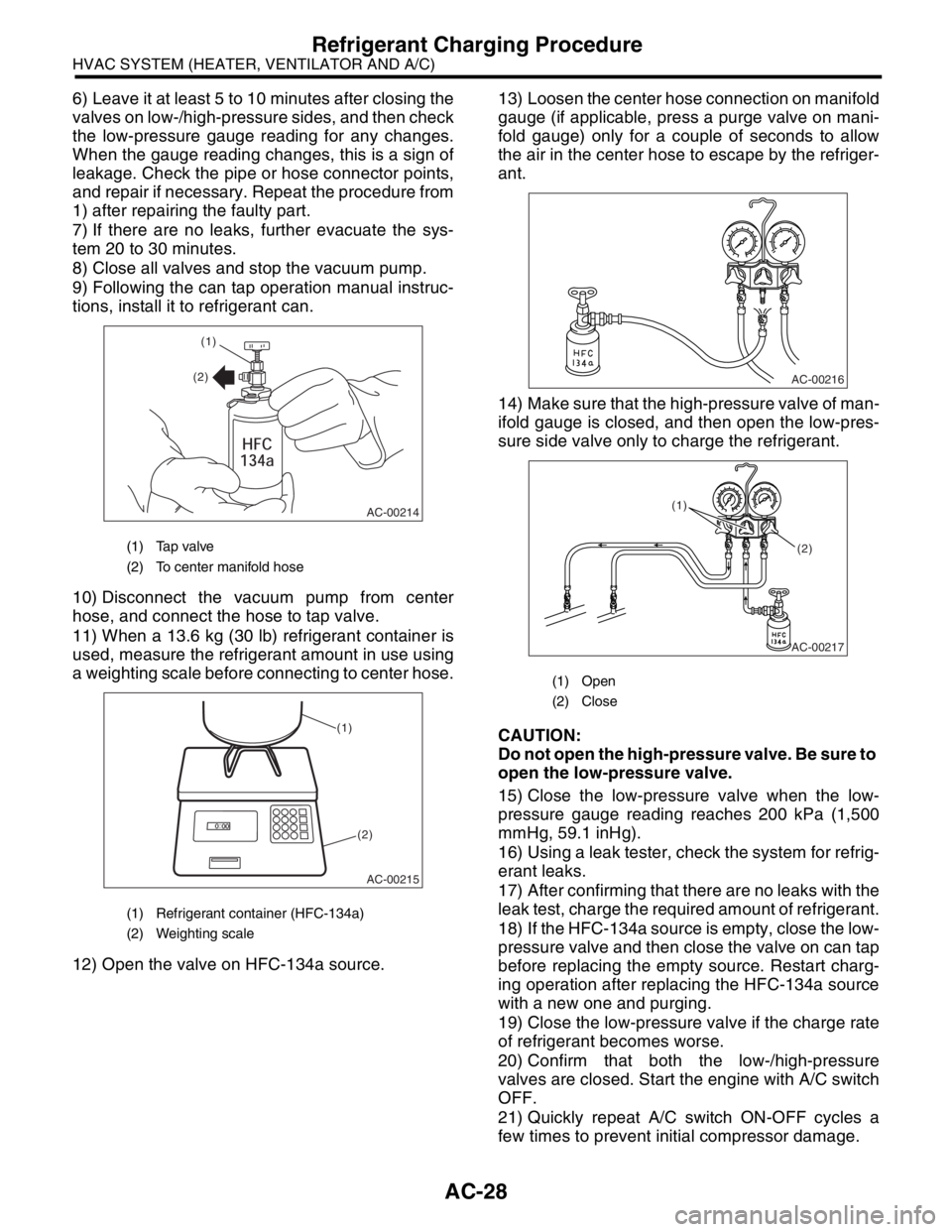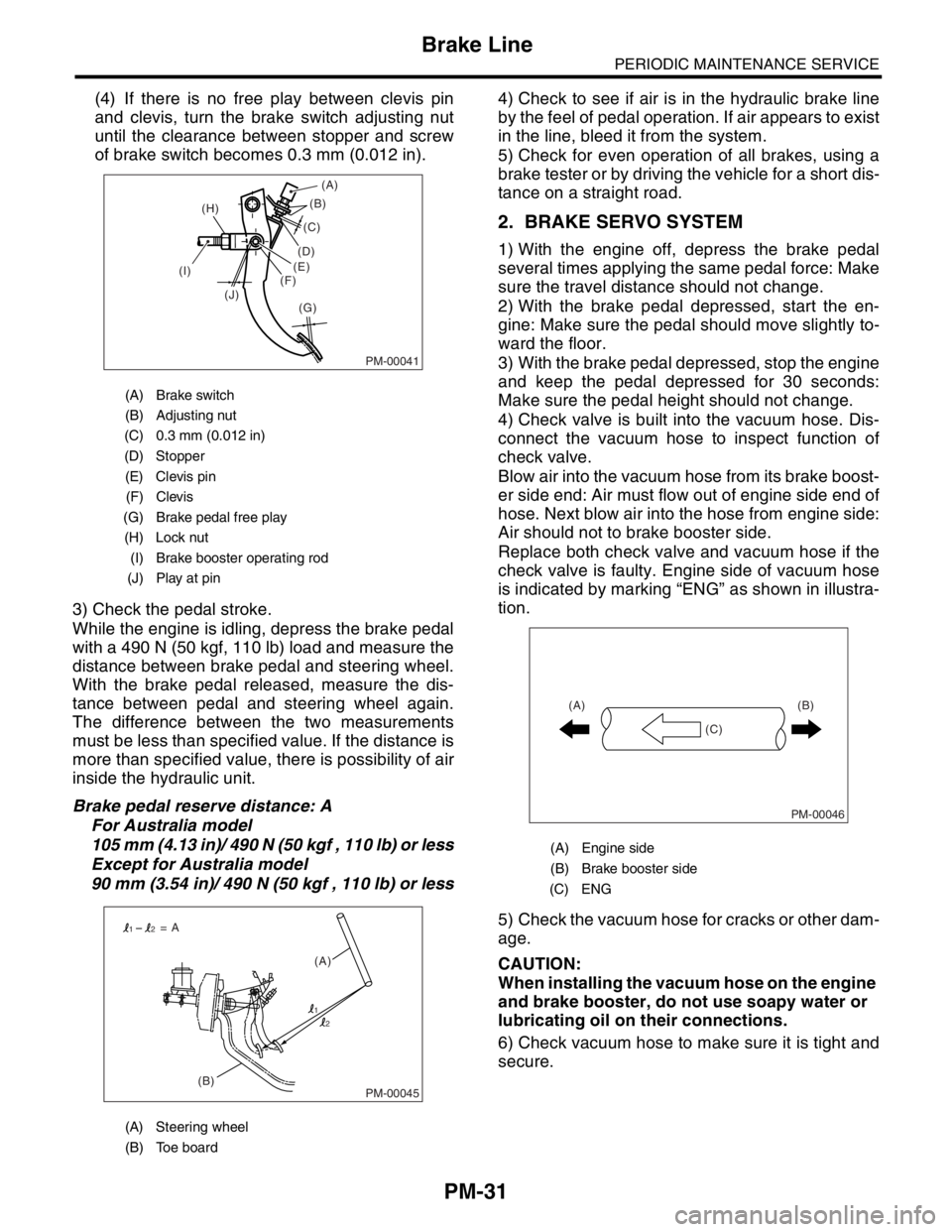change time SUBARU FORESTER 2004 Service Repair Manual
[x] Cancel search | Manufacturer: SUBARU, Model Year: 2004, Model line: FORESTER, Model: SUBARU FORESTER 2004Pages: 2870, PDF Size: 38.67 MB
Page 30 of 2870

AC-28
HVAC SYSTEM (HEATER, VENTILATOR AND A/C)
Refrigerant Charging Procedure
6) Leave it at least 5 to 10 minutes after closing the
valves on low-/high-pressure sides, and then check
the low-pressure gauge reading for any changes.
When the gauge reading changes, this is a sign of
leakage. Check the pipe or hose connector points,
and repair if necessary. Repeat the procedure from
1) after repairing the faulty part.
7) If there are no leaks, further evacuate the sys-
tem 20 to 30 minutes.
8) Close all valves and stop the vacuum pump.
9) Following the can tap operation manual instruc-
tions, install it to refrigerant can.
10) Disconnect the vacuum pump from center
hose, and connect the hose to tap valve.
11) When a 13.6 kg (30 lb) refrigerant container is
used, measure the refrigerant amount in use using
a weighting scale before connecting to center hose.
12) Open the valve on HFC-134a source.13) Loosen the center hose connection on manifold
gauge (if applicable, press a purge valve on mani-
fold gauge) only for a couple of seconds to allow
the air in the center hose to escape by the refriger-
ant.
14) Make sure that the high-pressure valve of man-
ifold gauge is closed, and then open the low-pres-
sure side valve only to charge the refrigerant.
CAUTION:
Do not open the high-pressure valve. Be sure to
open the low-pressure valve.
15) Close the low-pressure valve when the low-
pressure gauge reading reaches 200 kPa (1,500
mmHg, 59.1 inHg).
16) Using a leak tester, check the system for refrig-
erant leaks.
17) After confirming that there are no leaks with the
leak test, charge the required amount of refrigerant.
18) If the HFC-134a source is empty, close the low-
pressure valve and then close the valve on can tap
before replacing the empty source. Restart charg-
ing operation after replacing the HFC-134a source
with a new one and purging.
19) Close the low-pressure valve if the charge rate
of refrigerant becomes worse.
20) Confirm that both the low-/high-pressure
valves are closed. Start the engine with A/C switch
OFF.
21) Quickly repeat A/C switch ON-OFF cycles a
few times to prevent initial compressor damage.
(1) Tap valve
(2) To center manifold hose
(1) Refrigerant container (HFC-134a)
(2) Weighting scale
AC-00214
(1)
(2)
AC-00215
(1)
(2)
(1) Open
(2) Close
AC-00216
AC-00217
(1)
(2)
Page 60 of 2870

AC-4
HVAC SYSTEM (AUTO A/C)(DIAGNOSTIC)
General Description
5. CONTROL SWITCHES
Start and warm-up the engine completely.
1) Inspection using switches
2) Compressor operation inspection
3) Inspection of illumination control
No. Point to check Switch operation Judgment standard
1 Fan speed control dial Turn the fan speed control dial clockwise.Fan speed changes 1st → 2nd → 3rd → 4th
as dial turn.
2AUTO switch1) Press the AUTO switch.
2) Turn the temperature control dial to the left
fully, and set maximum cool position. Outlet air temperature: COOL
Fan speed: 4th
Outlet opening: VENT
Inlet opening: RECIRC
Compressor: AUTO
3) Turn the temperature control dial to the right
slowly, and change the setting from maximum
cool position to maximum hot position gradually. Outlet air temperature: COOL → HOT
Fan speed: AUTO
Outlet opening: AUTO
Inlet opening: AUTO
Compressor: AUTO
4) Turn the temperature control dial to the right
fully, and set maximum hot position. Outlet air temperature: HOT
Fan speed: 4th
Outlet opening: HEAT
Inlet opening: FRESH
Compressor: AUTO
3 Defroster switch Press the defroster switch. Outlet air temperature: AUTO
Fan speed: AUTO
Outlet opening: DEF
Inlet opening: FRESH
Compressor: ON
4FRESH/RECIRC
switchPress the FRESH/RECIRC switch.Inlet opening switches RECIRC → FRESH or
FRESH → RECIRC each time pressing the
switch.
5 Mode control dial Press the mode control dial.Outlet opening switches VENT → BI-LEVEL
→ HEAT → DEF/HEAT each time dialing
clockwise.
No. Point to check Switch operation Judgment standard
1 Compressor1) A/C switch is turned to ON.
2) Turn the fan speed control clockwise.Compressor: ON
No. Point to check Switch operation Judgment standard
1 Illumination1) Turn the lighting switch to ON. Illumination comes on.
2) Press the OFF switch one second or more. Illumination dimming is cancelled.
Page 683 of 2870

FW-2
FOREWORD
Foreword
1. Foreword
A: FOREWORD
These manuals are used when performing mainte-
nance, repair, or diagnosis of the Subaru FOREST-
ER.
Applied model: SG***** from 2004MY
The manuals contain the latest information at the
time of publication. Changes in specifications,
methods, etc. may be made without notice.
Page 714 of 2870

ID-5
IDENTIFICATION
Identification
3. MODEL NUMBER PLATE
The model number plate indicates: the applied model, the option code, the trim code, the engine type, the
transmission type, and the exterior color code. This information is helpful when placing orders for parts.
SG5BL1K
The engine and transmission type are as follows:
Engine
EJ201NWTAA
Digits Code Meaning Details
1 S Series S: FORESTER
2 G Body type G: Wagon
3 5 Engine displacement
Drive system
Suspension system5: 2.0 L AWD
9: 2.5 L AWD
4 B Minor change B: 2004MY
5 L Destination K: RHD (Right-hand drive)
L: LHD (Left-hand drive)
6 1 Grade 1: 2.0X
3: HUNTER Ver
5: 2.0XT
7: 2.5X
B: 2.5XT
7 K Transmission, fuel feed
systemR: SOHC MPI 4-speed AT
K: SOHC MPI Full-time AWD 5-speed MT Dual range
D: DOHC Turbo Full-time AWD 5-speed MT
P: DOHC Turbo 4-speed AT
T: DOHC Turbo 4-speed D-AT
Digits Code Meaning Details
1 and 2 EJ Engine type EJ: 4 cylinders
3 and 4 20 Displacement 20: 2.0L
25: 2.5L
5 1 Fuel feed system 1: D-MPI SOHC-A
5: L-MPI Turbo
6 N Emission control M: Unleaded non-STEP-III
N: Unleaded STEP-III
7 W Transmission W: MT
Y: MT (Response to CO
2 emission control)
X: AT
V: AT (Response to CO
2 emission control)
8 T Minor change T: 2004MY
9 to 10 AA Detailed specifications Used when ordering parts. See the parts catalog for details.
Page 715 of 2870

ID-6
IDENTIFICATION
Identification
Transmission
TY755XF3AA
Rear differential 1
VA1REK
Rear differential 2
HP
Option code
ECAJ
Digits Code Meaning Details
1 T Transmission T: Transmission
2 Y Transmission type Y: Full-time AWD MT center differential
Z: Full-time AWD AT MPT
3 and 4 75 Classification 75: MT
1A: AT
1B: AT
55 Series 3: AT
5: MT
6 X Transmission specifica-
tionsV: Full-time AWD 5-speed MT with viscous coupling center dif-
ferential single range
X: Full-time AWD 5-speed MT Dual range with viscous cou-
pling center differential
Z: Full-time AWD 4-speed AT with MPT
L: Full-time AWD 4-speed AT with MPT Turbo
7 F Mounted body F: 2.5L SOHC
R: 2.0L SOHC
N: 2.0L DOHC Turbo
H: 2.5L DOHC Turbo
8 3 Minor change 3: Initial
9 to 10 AA Detailed specifications Used when ordering parts. See the parts catalog for details.
Digits Code Meaning Details
1 V Fo r AW D V: AW D
2 A Type A: A type
3 1 Hypoid gear diameter
mm (in)1: 152 (6.0) dia.
4 R Installation position R: Rear
5 E Reduction gear ratio E: 4.111
F: 4.444
6 K Specification differ-
ences—
Code Reduction gear ratio LSD
HP 4.111 Viscous
JP 4.111 Viscous
CF 4.444 Viscous
Digits Code Meaning Details
1 to 2 EC Destination EC: EC
K4: K4
KS: KS
EK: EK
KA: KA
3 to 4 AJ Main option of vehicle —
Page 768 of 2870

PM-31
PERIODIC MAINTENANCE SERVICE
Brake Line
(4) If there is no free play between clevis pin
and clevis, turn the brake switch adjusting nut
until the clearance between stopper and screw
of brake switch becomes 0.3 mm (0.012 in).
3) Check the pedal stroke.
While the engine is idling, depress the brake pedal
with a 490 N (50 kgf, 110 lb) load and measure the
distance between brake pedal and steering wheel.
With the brake pedal released, measure the dis-
tance between pedal and steering wheel again.
The difference between the two measurements
must be less than specified value. If the distance is
more than specified value, there is possibility of air
inside the hydraulic unit.
Brake pedal reserve distance: A
For Australia model
105 mm (4.13 in)/ 490 N (50 kgf , 110 lb) or less
Except for Australia model
90 mm (3.54 in)/ 490 N (50 kgf , 110 lb) or less4) Check to see if air is in the hydraulic brake line
by the feel of pedal operation. If air appears to exist
in the line, bleed it from the system.
5) Check for even operation of all brakes, using a
brake tester or by driving the vehicle for a short dis-
tance on a straight road.
2. BRAKE SERVO SYSTEM
1) With the engine off, depress the brake pedal
several times applying the same pedal force: Make
sure the travel distance should not change.
2) With the brake pedal depressed, start the en-
gine: Make sure the pedal should move slightly to-
ward the floor.
3) With the brake pedal depressed, stop the engine
and keep the pedal depressed for 30 seconds:
Make sure the pedal height should not change.
4) Check valve is built into the vacuum hose. Dis-
connect the vacuum hose to inspect function of
check valve.
Blow air into the vacuum hose from its brake boost-
er side end: Air must flow out of engine side end of
hose. Next blow air into the hose from engine side:
Air should not to brake booster side.
Replace both check valve and vacuum hose if the
check valve is faulty. Engine side of vacuum hose
is indicated by marking “ENG” as shown in illustra-
tion.
5) Check the vacuum hose for cracks or other dam-
age.
CAUTION:
When installing the vacuum hose on the engine
and brake booster, do not use soapy water or
lubricating oil on their connections.
6) Check vacuum hose to make sure it is tight and
secure.
(A) Brake switch
(B) Adjusting nut
(C) 0.3 mm (0.012 in)
(D) Stopper
(E) Clevis pin
(F) Clevis
(G) Brake pedal free play
(H) Lock nut
(I) Brake booster operating rod
(J) Play at pin
(A) Steering wheel
(B) Toe board
PM-00041
(B)
(G) (H)
(I)
(J)(C)
(D)
(E)
(F)(A)
PM-00045(B)(A) = A
1
12
2
(A) Engine side
(B) Brake booster side
(C) ENG
PM-00046
(B)
(C) (A)
Page 1733 of 2870

EN(H4DOTC)-100
ENGINE (DIAGNOSTIC)
Diagnostic Procedure with Diagnostic Trouble Code (DTC)
Step Check Yes No
1 CONNECT SUBARU SELECT MONITOR OR
THE OBD-II GENERAL SCAN TOOL, AND
READ DATA.
1) Turn the ignition switch to OFF.
2) Connect the Subaru Select Monitor or the
OBD-II general scan tool to data link connec-
tor.
3) Turn the ignition switch to ON and the Sub-
aru Select Monitor or OBD-II general scan tool
switch to ON.
4) Start the engine.
5) Connect the Subaru Select Monitor or
OBD-II general scan tool, and read the mass
air flow sensor voltage.
N
OTE:
Subaru Select Monitor
For detailed operation procedure, refer to
“READ CURRENT DATA SHOWN ON DIS-
PLAY FOR ENGINE”.
OBD-II general scan tool
For detailed operation procedures, refer to the
OBD-II General Scan Tool Operation Manual.Is the voltage 0.2 — 4.7 V? Even if the mal-
function indicator
light illuminates,
the circuit has
returned to a nor-
mal condition at
this time.A tempo-
rary poor contact
of the connector or
harness may be
the cause.Repair
harness or con-
nector in the mass
air flow sensor.
NOTE:
In this case repair
the following:
Open or ground
short circuit in har-
ness between
mass air flow sen-
sor and ECM con-
nector
Poor contact in
mass air flow sen-
sor or ECM con-
nectorGo to step 2.
2 CHECK INPUT SIGNAL FROM ECM.
Measure the voltage between ECM connector
and chassis ground while engine is idling.
Connector & terminal
(B136) No. 23 (+) — Chassis ground (
−):Is the voltage more than 0.2 V? Go to step 4.Go to step 3.
3 CHECK INPUT SIGNAL FOR ECM (WITH
SUBARU SELECT MONITOR).
Measure the voltage between ECM connector
and chassis ground while engine is idling.Does the voltage change by
shaking the harness and con-
nector of ECM while monitor-
ing the value with Subaru
Select Monitor?Repair the poor
contact in ECM
connector.Contact the SUB-
ARU dealer.
N
OTE:
Inspection by DTM
is required, because
probable cause is
deterioration of mul-
tiple parts.
4 CHECK POWER SUPPLY TO MASS AIR
FLOW SENSOR.
1) Turn the ignition switch to OFF.
2) Disconnect the connector from mass air
flow sensor.
3) Turn the ignition switch to ON.
4) Measure voltage between mass air flow
sensor connector and chassis ground.
Connector & terminal
(B3) No. 1 (+) — Chassis ground (
−):Is the voltage more than 5 V? Go to step 5.Repair open circuit
between mass air
flow sensor and
main relay
Page 1759 of 2870

EN(H4DOTC)-126
ENGINE (DIAGNOSTIC)
Diagnostic Procedure with Diagnostic Trouble Code (DTC)
Step Check Yes No
1 CHECK CURRENT DATA.
1) Start the engine.
2) Read the data of throttle position sensor
signal using Subaru Select Monitor or OBD-II
general scan tool.
N
OTE:
Subaru Select Monitor
For detailed operation procedure, refer to
“READ CURRENT DATA SHOWN ON DIS-
PLAY FOR ENGINE”.
OBD-II general scan tool
For detailed operation procedures, refer to the
OBD-II General Scan Tool Operation Manual.Is the voltage less than 0.15
V?Go to step 2.Even if the mal-
function indicator
light illuminates,
the circuit has
returned to a nor-
mal condition at
this time.A tempo-
rary poor contact
of the connector
may be the cause.
N
OTE:
In this case repair
the following:
Poor contact in
throttle position
sensor connector
Poor contact in
ECM connector.
Poor contact in
coupling connector
2 CHECK INPUT SIGNAL FROM ECM.
Measure the voltage between ECM connector
and chassis ground while throttle valve is fully
closed.
Connector & terminal
(B136) No. 16 (+) — Chassis ground (
−):Is the voltage more than 4.5 V? Go to step 4.Go to step 3.
3 CHECK INPUT SIGNAL FROM ECM.
Measure the voltage between ECM connector
and chassis ground.
Connector & terminal
(B136) No. 16 (+) — Chassis ground (
−):Does the voltage change by
shaking the harness and con-
nector of ECM while monitor-
ing the value with voltage
meter?Repair the poor
contact in ECM
connector.Contact the SUB-
ARU dealer.
N
OTE:
Inspection by DTM
is required, be-
cause probable
cause is deteriora-
tion of multiple
parts.
4 CHECK INPUT SIGNAL FROM ECM.
Measure the voltage between ECM connector
and chassis ground.
Connector & terminal
(B136) No. 18 (+) — Chassis ground (
−):Is the voltage less than 0.15
V?Go to step 6.Go to step 5.
5 CHECK INPUT SIGNAL FOR ECM (WITH
SUBARU SELECT MONITOR).
Measure the voltage between ECM connector
and chassis ground.Does the voltage change by
shaking the harness and con-
nector of ECM while monitor-
ing the value with Subaru
Select Monitor?Repair the poor
contact in ECM
connector.Go to step 6.
Page 1828 of 2870

EN(H4DOTC)-195
ENGINE (DIAGNOSTIC)
Diagnostic Procedure with Diagnostic Trouble Code (DTC)
Step Check Yes No
1 CHECK SPEEDOMETER AND TACHOME-
TER OPERATION IN COMBINATION
METER.Does the speedometer and
tachometer operate normally?Go to step 2.Repair or replace
the combination
meter.
Meter System.>
2 CHECK INPUT SIGNAL FROM ECM.
1) Turn the ignition switch to ON.(engine OFF)
2) Measure the voltage between ECM con-
nector and chassis ground.
Connector & terminal
(B136) No. 20 (+) — Chassis ground (
−):Is the voltage less than 0.12
V?Go to step 4.Go to step 3.
3 CHECK INPUT SIGNAL FOR ECM (WITH
SUBARU SELECT MONITOR).
Read the data of fuel level sensor signal using
Subaru Select Monitor.
N
OTE:
Subaru Select Monitor
For detailed operation procedure, refer to
“READ CURRENT DATA SHOWN ON DIS-
PLAY FOR ENGINE”.
shaking the harness and con-
nector of ECM while monitor-
ing the value with Subaru
Select Monitor?Repair the poor
contact in ECM
connector.Even if the mal-
function indicator
light illuminates,
the circuit has
returned to a nor-
mal condition at
this time.A tempo-
rary poor contact
of the connector
may be the cause.
N
OTE:
In this case repair
the following:
Poor contact in
combination meter
connector
Poor contact in
ECM connector
Poor contact in
coupling connector
4 CHECK INPUT VOLTAGE OF ECM.
1) Turn the ignition switch to OFF.
2) Separate fuel tank cord connector (R57)
and rear wiring harness connector (R15).
3) Turn the ignition switch to ON.
4) Measure the voltage of harness between
ECM connector and chassis ground.
Connector & terminal
(B136) No. 20 (+) — Chassis ground (
−):Is the voltage more than 0.12
V?Go to step 5.Go to step 6.
5 CHECK HARNESS BETWEEN ECM AND
COMBINATION METER.
1) Turn the ignition switch to OFF.
2) Disconnect the connector from connector
(i10), (i11) and ECM connector.
3) Measure the resistance between ECM and
chassis ground.
Connector & terminal
(B136) No. 20 — Chassis ground:Is the resistance more than 1
MΩ?Go to step 7.Repair the ground
short in harness
between ECM and
combination meter
connector.
6 CHECK HARNESS BETWEEN ECM AND
COMBINATION METER.
Measure the resistance between ECM and
combination meter connector.
Connector & terminal
(B136) No. 20 — (i11) No. 1:Is the resistance less than 10
Ω?Repair or replace
the combination
meter.
Meter System.>Repair open circuit
between ECM and
combination meter
connector.
N
OTE:
In this case repair
the following:
Poor contact in
coupling connector
Page 1883 of 2870

EN(H4DOTC)-250
ENGINE (DIAGNOSTIC)
Diagnostic Procedure with Diagnostic Trouble Code (DTC)
Step Check Yes No
1 CHECK CURRENT DATA.
1) Start the engine.
2) Read the data of throttle position sensor
signal using Subaru Select Monitor or OBD-II
general scan tool.
N
OTE:
Subaru Select Monitor
For detailed operation procedure, refer to
“READ CURRENT DATA SHOWN ON DIS-
PLAY FOR ENGINE”.
OBD-II general scan tool
For detailed operation procedures, refer to the
OBD-II General Scan Tool Operation Manual.Is the voltage less than 0.1 V? Go to step 2.Even if the mal-
function indicator
light illuminates,
the circuit has
returned to a nor-
mal condition at
this time.A tempo-
rary poor contact
of the connector
may be the cause.
N
OTE:
In this case repair
the following:
Poor contact in
throttle position
sensor connector
Poor contact in
ECM connector.
Poor contact in
coupling connector
2 CHECK INPUT SIGNAL FROM ECM.
Measure the voltage between ECM connector
and chassis ground while tumble generator
valve is fully closed.
Connector & terminal
(B136) No. 16 (+) — Chassis ground (
−):Is the voltage more than 4.5 V? Go to step 4.Go to step 3.
3 CHECK INPUT SIGNAL FROM ECM.
Measure the voltage between ECM connector
and chassis ground.
Connector & terminal
(B136) No. 16 (+) — Chassis ground (
−):Does the voltage change by
shaking the harness and con-
nector of ECM while monitor-
ing the value with voltage
meter?Repair the poor
contact in ECM
connector.Contact the SUB-
ARU dealer.
N
OTE:
Inspection by DTM
is required, be-
cause probable
cause is deteriora-
tion of multiple
parts.
4 CHECK INPUT SIGNAL FROM ECM.
Measure the voltage between ECM connector
and chassis ground.
Connector & terminal
(B136) No. 26 (+) — Chassis ground (
−):Is the voltage less than 0.1 V? Go to step 6.Go to step 5.
5 CHECK INPUT SIGNAL FOR ECM (WITH
SUBARU SELECT MONITOR).
Measure the voltage between ECM connector
and chassis ground.Does the voltage change by
shaking the harness and con-
nector of ECM while monitor-
ing the value with Subaru
Select Monitor?Repair the poor
contact in ECM
connector.Go to step 6.